Backup WordPress: The Ultimate Guide
If you have a WordPress website, WordPress backups should be at the top of your priority list to protect your online work. The importance of a WordPress backup plan is one of the key things to understand as you create and grow your website. In this guide, we'll show you exactly why you should backup your WordPress site.

If you have a WordPress website, WordPress backups should be at the top of your priority list to protect your online work. The importance of a WordPress backup plan is one of the key things to understand as you create and grow your website.
In this guide, we’ll show you exactly why you should backup your WordPress site. We’ll take you step-by-step through the various ways that you can backup WordPress and be ready to restore it if the worst-case scenario should happen. We’ll also cover the best WordPress backup solutions and keep your backups current with the least amount of effort possible. Let’s dive in!
What Is a WordPress Backup?
A WordPress backup is essentially a copy of your WordPress website at any point in time. Simliar to backups of your computer, phone, or hard drive, a WordPress website needs a backup to capture changes and additions to the files that make your website function.
What Does it Mean to Backup WordPress?
A WordPress backup is a fully functional copy of your WordPress database and files. If your website becomes corrupted or lost for any reason, having a backup of your entire site will allow you to immediately bring the website back to a point in time before it crashed or was compromised.
A WordPress website is comprised of a database and many, many files. The files that comprise your WordPress site consist of the WordPress core installation files plus a WordPress database with your site’s unique content, such as the contents of your posts and pages. Additionally, a WordPress website has files that operate your themes and plugins. These files are usually stored in the public_html directory on the web server that runs your website.
If you haven’t properly backed up your website and your data is hacked, lost, or corrupted, you’ll be left with nothing but a blank slate to start over with. You’ll have no other option than to start rebuilding the entire site from scratch. As you can imagine, that would be a nightmare scenario for almost every WordPress site owner.
But that’s where WordPress backups come into the picture to save the day and give you a better night’s sleep.
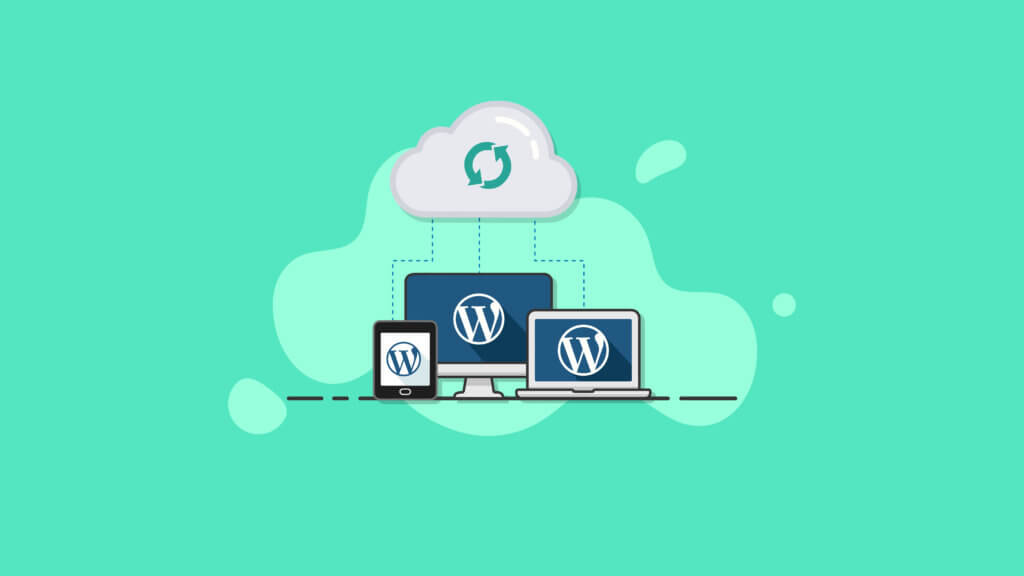
A backup copy of your WordPress site will save you a lot of time, energy and frustration if the worst should happen and your entire site is lost or corrupted.
What Does a WordPress Backup Do?
A WordPress backup makes a copy of your website’s files and database with a timestamp so you know exactly when the backup was taken.
No matter which backup technique you choose to utilize, a WordPress backup takes all of the data from your site files and database and puts them in a secure location, commonly called a “remote destination.”
A WordPress backup tool should also allow you to schedule backups to run automatically so you don’t have to remember to run them on your own.
Then, depending on when your most recent backup copy was made, your site can be instantly restored to that point no matter what has gone wrong with it.
The best WordPress backup tools have these qualities:
- Are easy to use and “just work”
- Are built with the needs of WordPress websites in mind
- Copy all files needed to fully restore your WordPress site, not just the database
- Automatically run backups of your website, behind the scenes, so that you don’t need to think about it or remember to do them manually
There are several techniques you can use to backup WordPress, and we’ll dive into them in just a bit. If you’re like most people, you’ll probably want to use the easiest and most effective WordPress backup tool available.
If you’ve never given much thought to backing up your WordPress site on a regular basis, you’re probably wondering why it’s such a vital step. After all, will the time it takes to keep your website backed up be worth it?
Why Do I Need to Backup WordPress?
You need a WordPress backup for a few important reasons you may not have considered before. Let’s cover the reasons why WordPress backups are so vital.
7 Reasons to Backup
First off, let’s cover why it’s so important to have a backup plan for your WordPress website. Here are a few reasons you need a backup of your site.
- Just like backing up your computer or phone, your website also needs a backup. Files on your computer or phone could potentially be lost, and the same is true for your website’s files. Your website’s files reside on a server, but these files can easily be deleted or lost entirely, so you’ll need a backup of all the files necessary to run your website.
- Your website faces security threats and data loss risks. The truth is, WordPress websites can be an easy target for hacks or security breaches if certain security measures are not implemented. A hacked website could mean permanent changes or corrupted files that make it impossible to get your website back … if you don’t have a backup. Additional risks include malware, server crashes, bad commands, and of course, user error.
- WordPress, by default, doesn’t have a built-in backup mechanism, so you’ll need to find a backup solution.WordPress is arguably the most powerful Content Management System (CMS) in existence today, but the software relies on users to take care of certain website management tasks, like updates, security … and backups.
- Your host’s backup may not be enough. Some hosts provide backups for your websites, so you think you’re covered. But these backups may fall short because they’re not actually designed specifically for WordPress websites. Host backups may lack the frequency, control or customization options you need. You may also have to rely on a support tech to manually restore your website if something goes wrong, costing you valuable downtime.
- Most websites change frequently, so backups need to happen frequently. Changes to your website include everything from new or updated content (like new blog posts or pages), purchases (if you run an ecommerce site), comments, new users, image or file uploads, or even version updates to your plugins, themes or WordPress core. Some of these changes may happen in the background, so you’ll want to capture all of them with frequent backups in case you need to revert back.
- Before running updates to your themes, plugins and WordPress core, you need a backup. Keeping your website’s software up to date is a very important security best practice because version updates to your themes, plugins and WordPress core often involve security patches. While most developer test backward compatibility before pushing updates, it’s also always a good idea to run a backup before updating anything in case something breaks.
- Backups are like insurance for your website. You may not think of it this way, but your website has a substantial monetary value, based solely on the time you’ve spent building, editing and maintaining it. In fact, we came up with a formula, much like your insurance company does on the “replacement” value of a car or house, and called it the Content Replacement Calculator.
How Often Should I Backup My WordPress Site?
You should backup your WordPress site as often as it changes.
“Changes” to your website encompass a variety of things you may have never considered before, as WordPress websites have a lot going on behind the scenes.
A few examples of changes to your website include:
- Adding/editing content (like adding new posts/pages)
- New transactions (if you run an ecommerce website or online store)
- Running version updates to your plugins, themes or WordPress core
- Uploading new plugins or themes
- New user registrations
- New comments
- Changes to settings
For example, when you update WordPress in any way, you should immediately run a full backup. This also applies to changes to:
- WordPress core version
- Themes
- Plugins
- Developmental changes
- Content
If you’re running a site with a lot of activity, you’re probably adding new content all the time. But what exactly qualifies as site content?
Content is anything that you create and publish on your site, including new:
- Articles and blogs
- Videos and photos
- Infographics
- Podcasts and other audio files
- A lot more
The frequency in which new content is added to the site is the biggest determining factor on how often you run backups. More active websites will have daily—or even hourly—changes. Regularly running WordPress backups, based on your site activity, is a hugely important step of the process that can’t be overlooked.
For example, if you run a restaurant website and only update it once-per-week with the weekly specials, you can run your backups once a week. However, if your site has a highly active blog or ecommerce platform and a lot of hour-by-hour activity, you’ll need to run backups many times every day.
Imagine the frustrating and time-consuming process of reposting (or even worse, rewriting and reposting) dozens of articles or product descriptions because you had a data breach and your site wasn’t backed up.
Moreover, if your site receives a lot of user comments or contact form responses, those interactions are recorded and stored in your WordPress database. If your user activity is constant and consistent, you’ll need to run an automated WordPress backup service.
Example Backup Schedules for a WordPress Site
WordPress users often ask “how often should I back up my site?” To help, here are two recommended WordPress backup schedule options to get you started:
- Starter: Monthly Complete Backup + Weekly Database Backup – This backup schedule will cover websites that get updated once a week or less by backing up the database. A complete backup will happen once a month to cover any other changes or updates.
- Active Blogger: Weekly Complete Backup + Daily Database Backup – This backup schedule is designed for more frequently-updated websites, such as bloggers who publish new content each day. This backup schedule would also work well for small ecommerce shops with daily to weekly sales.
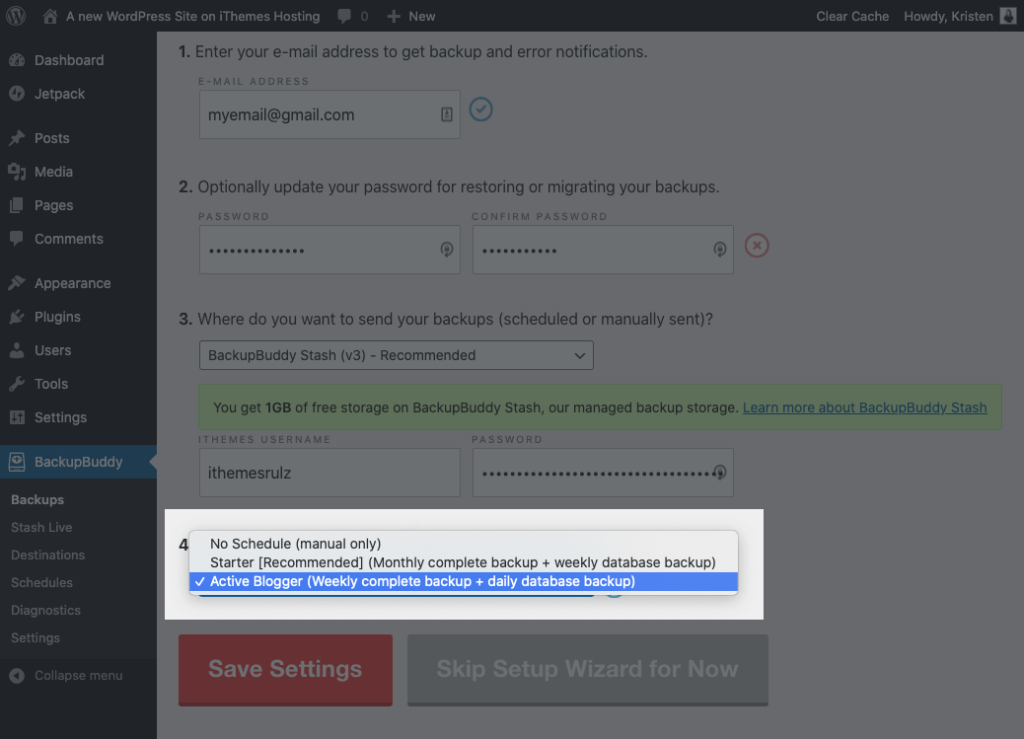
What Should a WordPress Backup Contain?
A WordPress backup should contain not just your WordPress database, but also all the files in your WordPress installation, your theme and plugin files, and your media library uploads. A complete WordPress backup is no small feat, because the backup solution will need to be “smart” enough to recognize all these files and folders.
While researching WordPress backup solutions for your site, you’ll probably come across several sources telling you how to backup only your WordPress database. And while that is a very important part of the process, a WordPress database backup doesn’t go nearly far enough.
For a full site backup, you’ll need to have stored copies of all:
- WordPress core files
- WordPress database
- WordPress media library
- WordPress plugin and theme files
While this may sound like a daunting process, we promise that there’s a simple solution that anyone can employ without a lot of effort. Don’t stop reading now!
How Do I Backup My WordPress Site?
As mentioned earlier, you have several different options for running WordPress backups. The one you choose may depend on your technical knowledge, the thoroughness of the result, and how quickly backups can be performed.
There are a few methods to perform a WordPress backup:
- Web host backup
- Manual backup method
- WordPress backup plugin
Let’s cover each of these backup approaches in more detail.
Web Host Backup
Your web hosting company may offer a backup option for your website. With it, you may be able to schedule some automatic site backups.
However, many backups provided by hosts only backup your database and fail to backup important site files. Or they don’t offer an easy way to download your backup files. Just check out this Is My Host’s Backup Enough? Infographic.
How to Perform a Manual WordPress Backup
It’s possible to manually backup your site by exporting your database and creating copies of all site files.
However, this can be a very time-consuming process that requires a decent amount of technical understanding and skill. If you’re comfortable with cPanel, FTP, and phpMyAdmin (and have some extra time on your hands), you might consider looking into the process of running manual backups.
If that doesn’t sound like how you want to spend time, there are some powerful backup plugin solutions that will get the job done for you with very minimal effort.
But if you’d rather tackle the job manually, you can do that as well. The first thing to do is to log into phpMyAdmin on your server. From the window on the left side of your screen, select the WordPress database that you want to backup.
The window on the right side will display all tables that are within the WordPress database. You’ll want to click on the “Export” tab on the top set of tabs.
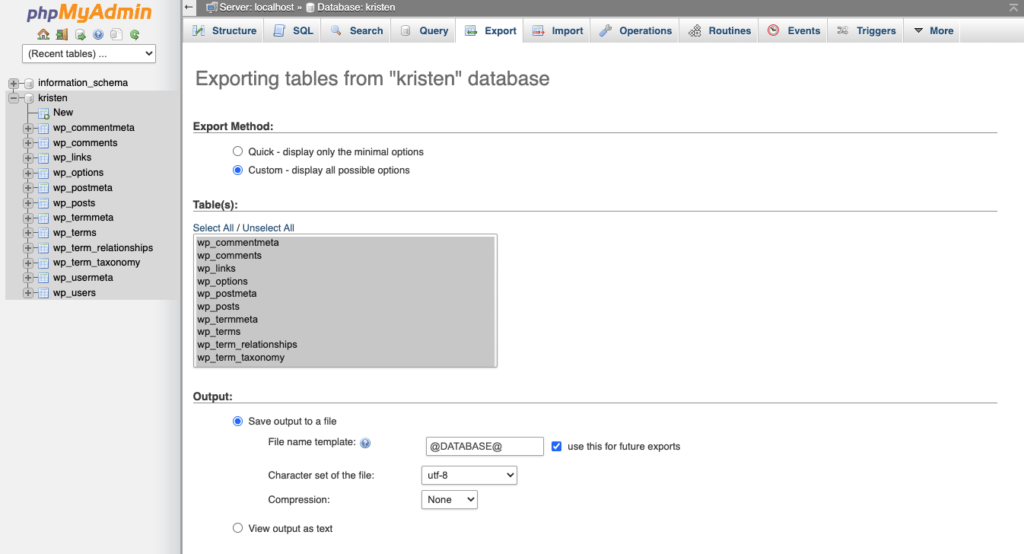
Select the Quick option and then click on “Go.” You’ll then get a prompt asking you to download a file.
Save this file to your computer. If the database is large, the download may take a few moments.
You can also choose the Custom backup option if you want to change the default behavior. In the above step, choose the “Custom” option instead of the “Quick” option. From there, you’ll see detailed options displayed.
The Table section is where you can select from all of the different tables in the database. If other programs are using the database, choose only the tables that correspond with your install of WordPress. They’ll be the ones starting with “wp_” or a “table_prefix” you already specified within your WordPress wp-config.php file.
If you only have WordPress installed, leave as is or click on “Select All” if the selection was changed. In the Output section, select “gzipped” or “zipped” from the Compression box. This will allow you to compress the data when you download it.
In the Format section, make sure to select SQL. This will export a sequence of SQL commands rather than other data formats such as CSV, which wouldn’t work for this backup process. When you see the Format-specific section, go ahead and leave things exactly as they are.
In the Object creation section, select the following:
- Drop Table
- View
- Procedure
- Function
- Event
- Trigger
Prior to the creation of the target database, it’ll call a DROP statement that deletes any old existing tables if they exist. After this, you’ll want to make sure to leave the Data creation options section exactly as they already are.
Head to the bottom of the window and click “Go.” You’ll be prompted to download a file. Save this file on your computer. Keep in mind that this process does not back up all your files and folders (like images). However, all of the things like blog posts and user comments have been backed up with this manual database backup process.
How to Use a WordPress Backup Plugin
The advantage of a WordPress backup plugin is that it was built specifically to backup WordPress. A WordPress backup plugin also allows you to perform backups from within your WordPress admin dashboard.
The choice in WordPress backup plugins range from 100% free choices to those who charge a premium fee. They also offer different levels of features and support.
BackupBuddy is one of the most popular and powerful WordPress backup plugins, with options to backup your files and database to secure, off-site storage locations. With the BackupBuddy plugin, you can perform a backup of your WordPress site with just a click of a button, right from your WordPress dashboard.
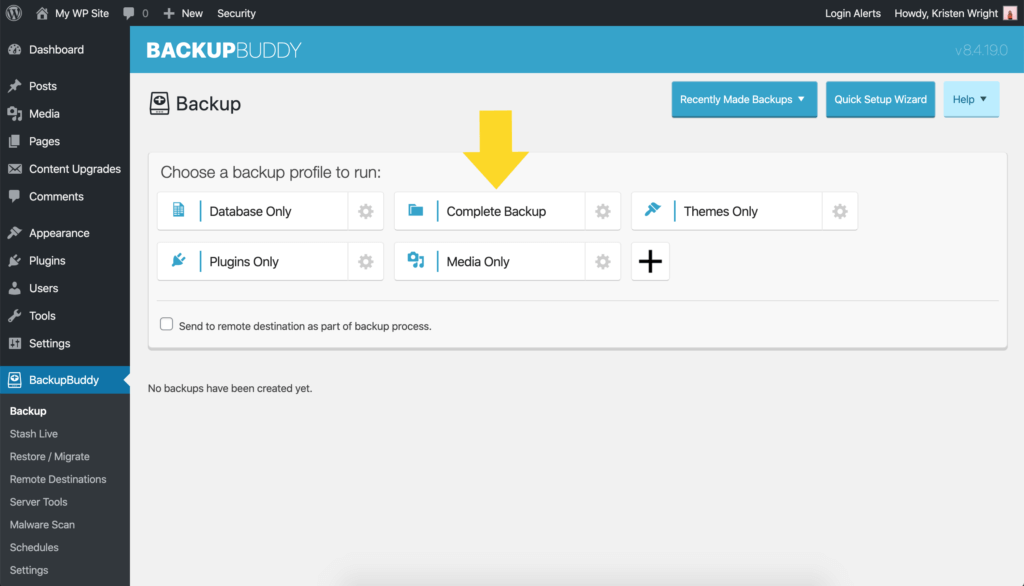
Skip ahead to the section that covers 10 features to look for in a WordPress backup plugin or download the entire ebook right now.
Get SolidWP tips direct in your inbox
Sign up
Get started with confidence — risk free, guaranteed
Where Are WordPress Backups Stored?
WordPress backups can be stored in a variety of locations, depending on the method you have used to backup your site.
In fact, after understanding the importance of having a WordPress backup, the next thing to consider is where your backup files are physically stored. The question of backup storage is often overlooked but is one of the most important factors to take into consideration when deciding on your overall WordPress backup process.
Let’s cover 3 common places WordPress backup files are stored:
- Web host storage
- Local backup storage
- Cloud backup storage
Web Host Storage
If your web host offers backup services for your web hosting plan, they’ll most likely manage the physical location of where your data is stored.
While this will certainly save you time and money, it also takes away your ability to control how the data is stored and the security protocols that surround it.
If you’re interested in learning the details of how and where your host stores your backup data, get in touch with them and start asking these important questions.
Local Backup Storage
A local backup is a backup file that is stored on the same server as your website. While this method of storing your backups may be a default setting for many backup solutions, there are several important reasons to not store backups locally.
- Since a local backup is stored on your site, it doesn’t offer protection against a crashed server or a broken site.
- There’s a good chance that if your website gets damaged, your local backups will be also damaged.
- If your site gets hacked and you lose access to your website, you also lose access to your local backup files.
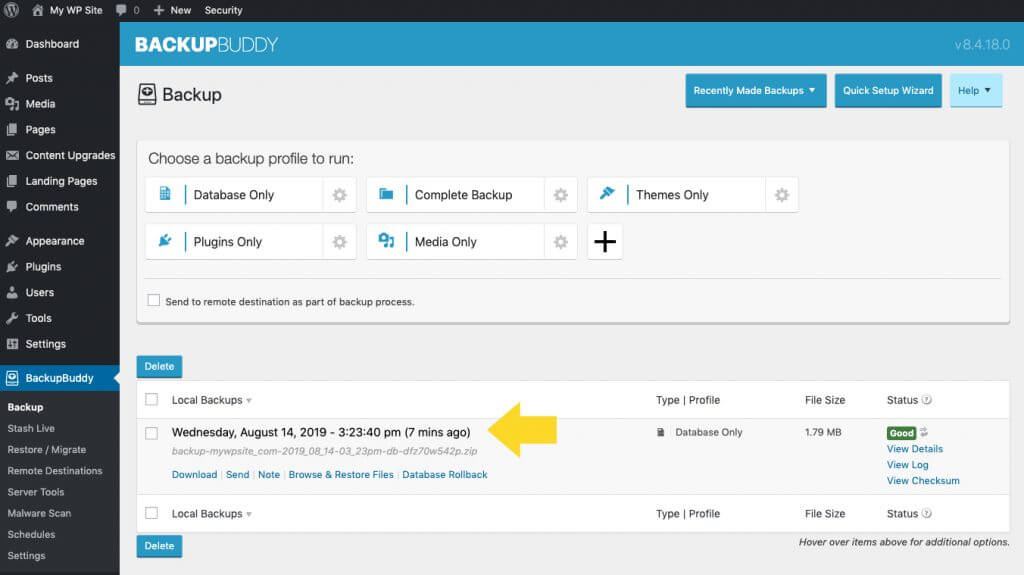
You could also store backups on an external hard drive, or right on your personal computer. However, opting for this route is not typically the best choice.
Remember that backups are only as secure as the hardware that stores them. If you have hardware issues, your computer crashes, or an external storage device is damaged or stolen, you’ll lose your backups or they could become compromised.
Because of this danger, if you decide to store backups locally, it’s vitally important to also save them in more secure locations, such as a secure, off-site remote destination. Your WordPress backup strategy isn’t complete without a secure, off-site place to store your backup files, called a remote destination.
A remote destination is a secure, off-site place to store your website’s backup files. A Remote Destination is usually cloud-based, meaning your files are housed on a network of remote servers in order to ensure data redundancy.
Data redundancy occurs when the same piece of data is stored in two or more separate places. Redundancy is especially important when it comes to storing backups (of your phone, digital photos, computer, and website) as you don’t want to ever risk losing your backup files. That’s where Remote Destinations come into the picture.
Cloud Backup Storage
For many WordPress developers, one of the most popular ways to save their backups in the cloud is through services like Amazon S3 or Dropbox. But remember, these backups are only as secure as the platforms they ride on. Before committing your vital data to the cloud, make sure to check that your data is safe from public access. It’s also a good idea to have extra backup copies saved.
Your WordPress backup solution will also need to integrate with cloud-based storage platforms so you can easily transfer and download your backup files.
The BackupBuddy plugin, for example, allows you to send your backups off-site to Amazon s3, Dropbox, Google Drive, OneDrive or even sFTP. You can easily setup and configure your connection settings so that backups get sent to your remote destination of choice. BackupBuddy handles the data transfer of your backup files so you don’t have to do it manually.
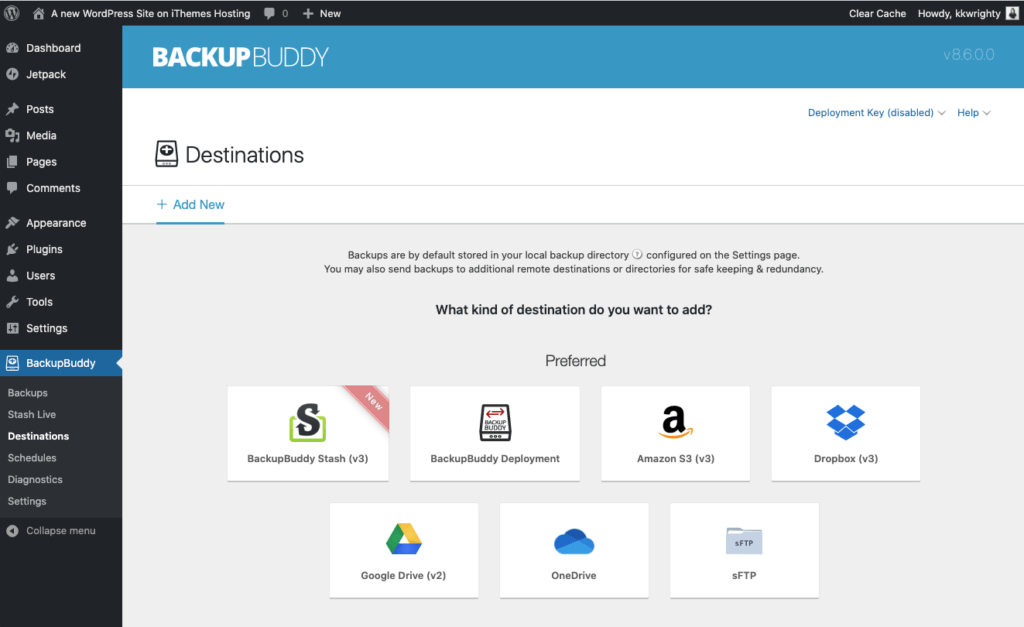
What Is the Best Backup Plugin for WordPress?
For the majority of WordPress users and website admins, using a WordPress backup plugin to backup their site to a secure location on the cloud is the best (and easiest) option.
But how do you choose the best backup plugin among the multitude of paid and free options available online and in the WordPress plugin repository?
10 Features to Look for in a WordPress Backup Plugin
If you’re looking for a solid answer that will lead you to the best solution for your project, make sure these 10 key features exist in the backup plugin you choose to run:
1. Full-Site (Complete) Backups
As we mentioned early, a WordPress backup plugin must be able to perform a complete website backup. Again, a database backup is not enough.

A full-site (Complete) backup must include:
- A complete and full copy of the WordPress database, including offering an option to have non-default tables excluded or included
- All server site directory files
- All theme and plugin files
- An option to include files and data that are non-WordPress related
If the plugin you’re looking at doesn’t backup all of these files, keep looking for another solution.
2. The Ability To Schedule Backups
If you’re like most WordPress users, you probably don’t live on your WordPress dashboard 24/7. After all, our lives are full of unexpected events and constant interruptions.
By working with a WordPress backup plugin that offers the ability to create WordPress backup schedules, you’re taking full responsibility to login and initiate your site backups on a regular basis.
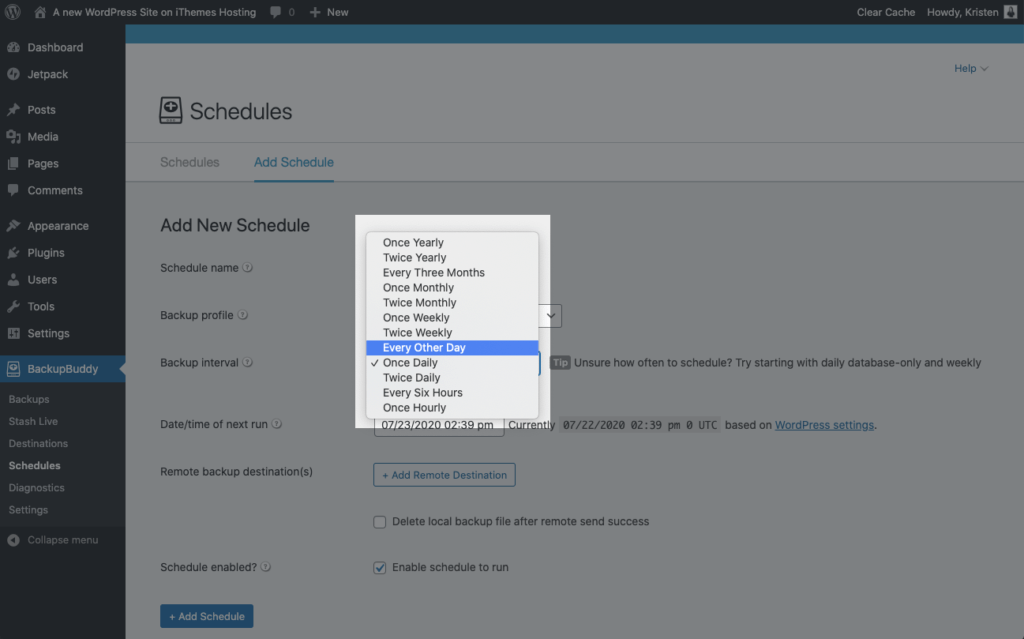
Remember, your wesite should be backed up every time there’s any change to it, whether it’s a change you initiated or one that a user did. If your site is highly active and your users are creating a steady flow of new data on the site (comments, purchases, etc.), it would be nearly impossible to manually initiate enough backups to keep up with the constant changes.
Because of this, a plugin that allows you to schedule your full-site backup frequency is a mandatory requirement for most WordPress developers.
3. Stores Backups in Multiple Off-Site Storage Locations
WordPress backup plugins can use several different off-site storage options, including:
- Dropbox
- Google Drive
- Amazon Web Services
- BackupBuddy Stash
- Remote servers (sFTP/FTP)
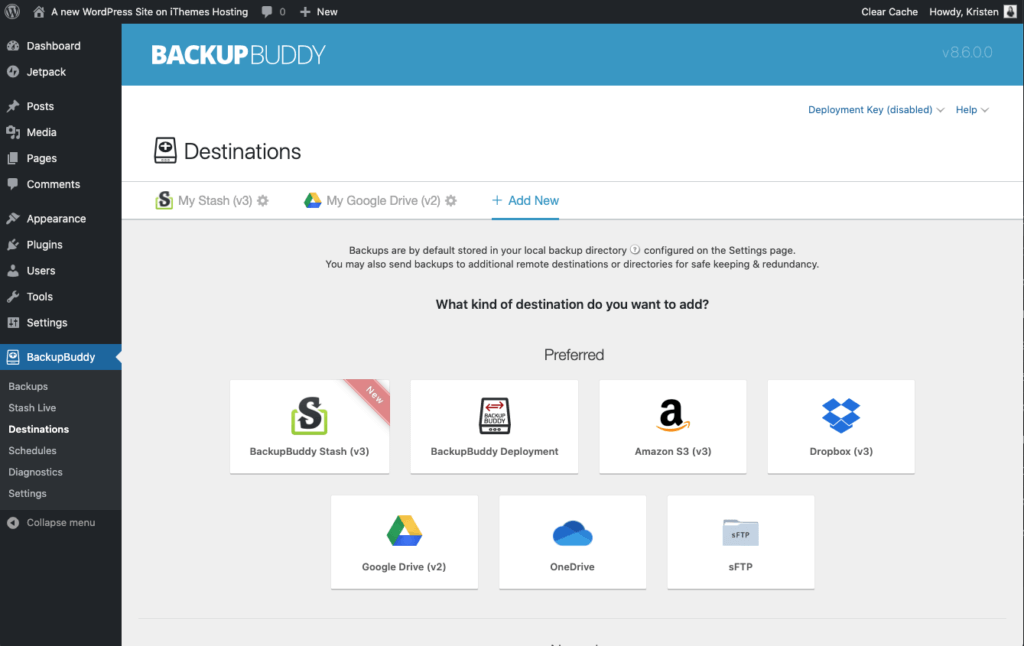
The most important factor to consider here is that the plugin offers multiple storage locations that you can choose from, and that you can use each location at the same time.
4. Fast and Easy Website Restores
No matter how well a WordPress backup plugin works to store your data, if you’re not able to recover and restore the data quickly and efficiently, it’s not the best backup plugin option to use.
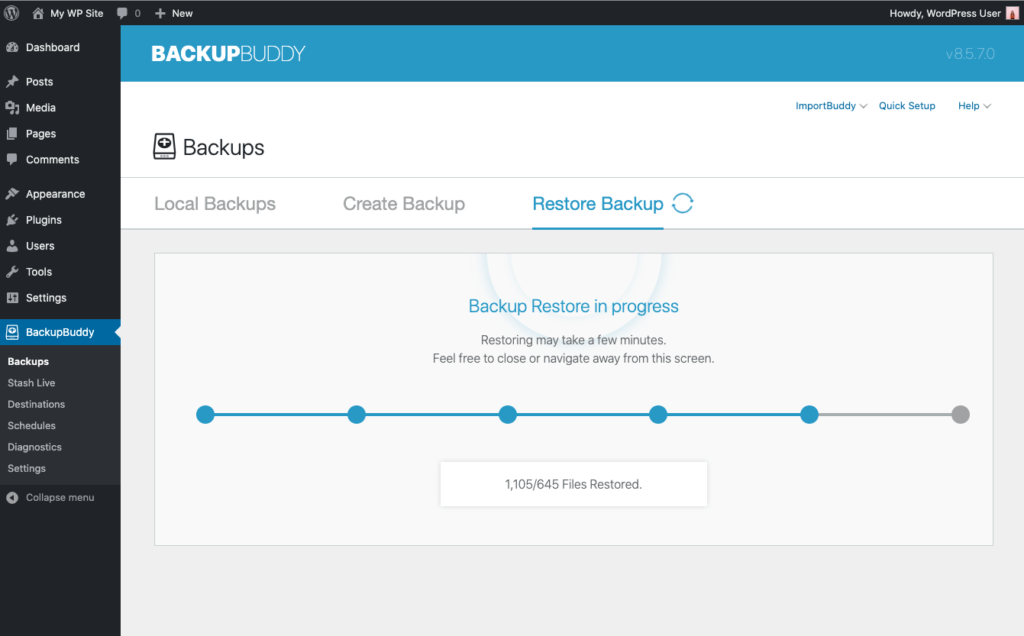
Ask these questions when you’re reviewing a backup plugin to employ on your WordPress site:
- Does it offer a solution for combining WordPress backup and restore?
- Will I be able to restore my website with the absolute minimal amount of downtime?
- What is the process of restoring a site that has gone down? What exactly will you need to do once the panicked feeling fades?
- Will you be able to overwrite existing files and databases?
- Does it give you the ability to choose to restore only files or only a database?
- Do you need access to your WordPress dashboard to restore your site (Hint, often when a WordPress site goes down, you won’t have access to the dashboard)?
- Can you restore your current WordPress version?
Remember, with the number of plugin options available on the market, there’s no need to compromise with any of these questions.
5. Customize Backup Contents
As we discussed earlier, a proper WordPress backup of your site needs to contain the whole of the site. But an added benefit to the plugin you choose is that you can use one that gives you the ability to customize what’s included in each backup.
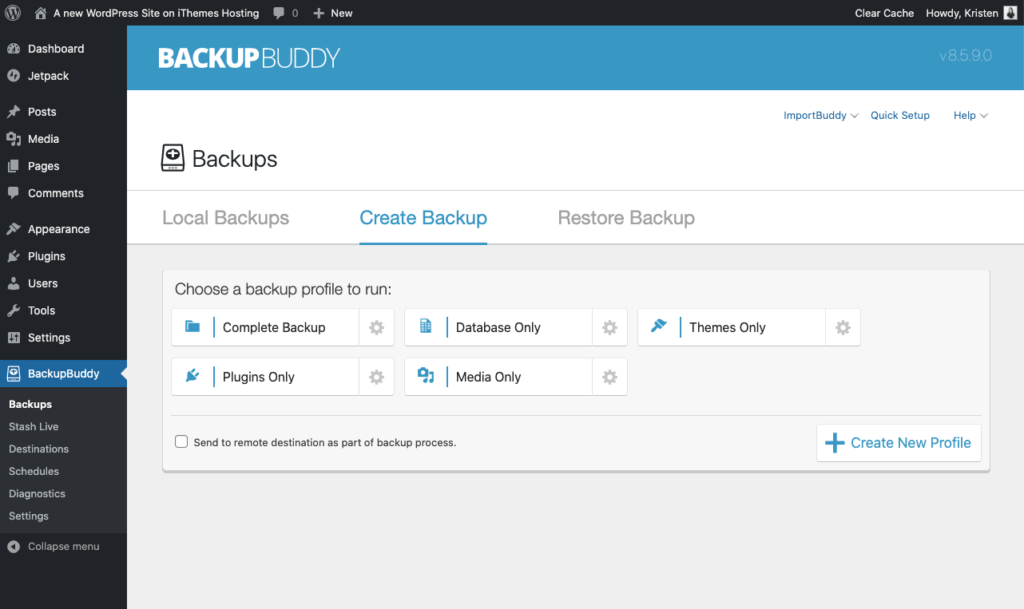
For some sites and circumstances, the ability in include or exclude specific database tables, files and folders can save a lot of time and server resources. For example, the BackupBuddy plugin offers 5 types of WordPress backups so you can run the type of backup you need.
6. Ability To Use a Backup File to Move Your Website
When it’s time to move a WordPress website to a new host or server, or if you’d like to move a WordPress website to a new domain, you might expect to spend hours manually completing the task. After all, a website migration can’t be done by simply uploading your backup files to a new location and bringing the site back up.
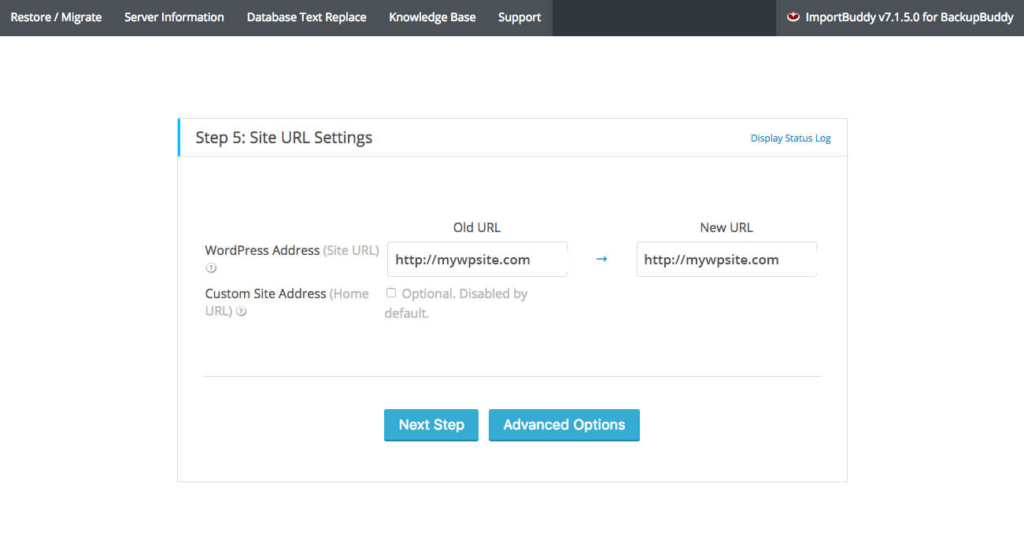
Before deciding on a WordPress backup plugin, find out if it can help you with full site migrations by asking these questions:
- Does it replace all coded URLs, including those in the database and options settings?
- Will it give you a way to search and replace text throughout the entire database and site?
- Will the plugin correctly handle serialized data, including that which is stored inside other serialized data?
- Does it have the ability to clone WordPress?
- Can it handle WordPress staging?
Without these abilities, the plugin won’t be much help when it’s time to migrate your site to a new host or server location.
7. Backup Email Notifications
Look for a backup plugin that features the ability to notify you via email when a task was completed or failed. Backup email notifications keep you in the loop on what’s happening with your WordPress backups so you always know the status of your backups.

8. Ability to Restore Plugins, Themes, WordPress Version and Individual Files
For those that develop WordPress sites for clients, all too often a client will make a mistake in the dashboard that requires you to step in with a quick fix.
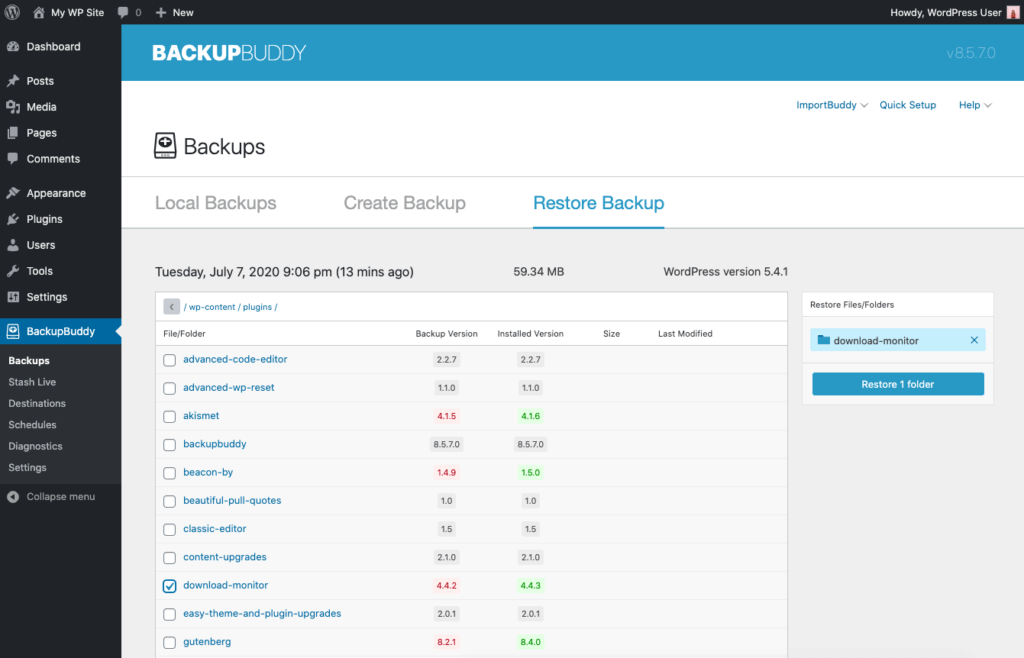
Of course, one option to perform the fix would be a full-site restore. But it’s a lot faster to jus restore individual files rather than the whole site.
In addition, it’s extremely helpful to be able to restore plugins or themes to previous versions if a version update has an issue. The same goes for rolling back to a previous WordPress version.
Make sure your plugin gives you this type of granular restoration option to restore plugins, themes, WordPress version and individual files.
9. Server Tools for Developers
There are several server-side tools and features that are extremely helpful and should be included in a robust WordPress backup plugin.
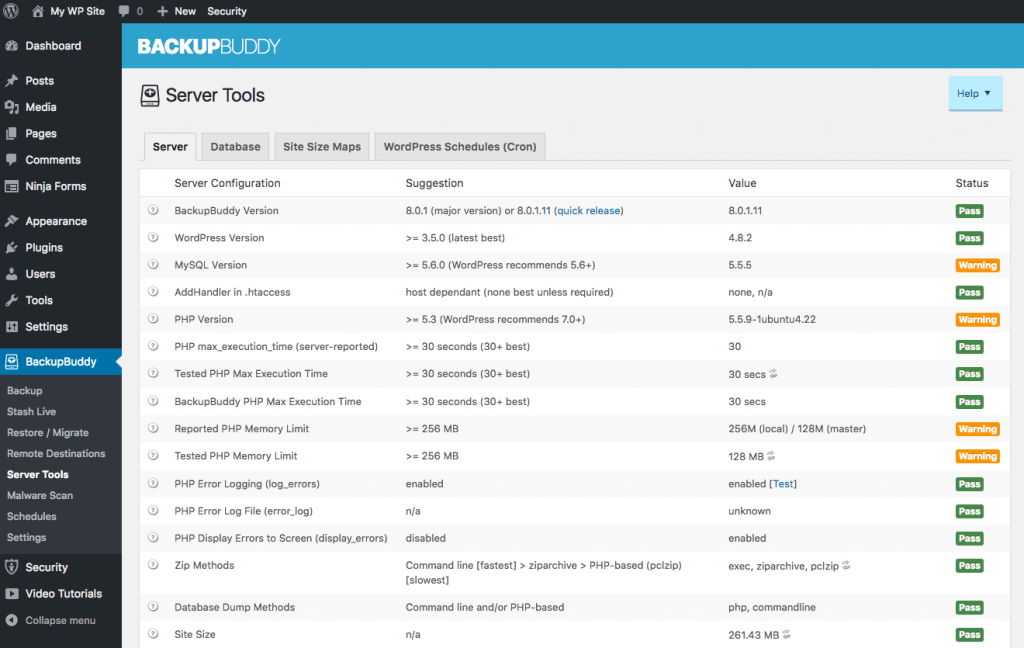
Some of these include:
- Malware scan
- Database scan and repair
- Storage and resource usage
- WordPress cron job management
Properly backing up your site calls for these sets of tools that are related to your server.
10. Automatic Backups
Last up, an automatic WordPress backup feature creates a “snapshot” of your site on a daily basis (automatically) and it also creates a separate “database-only” snapshot/backup regularly.
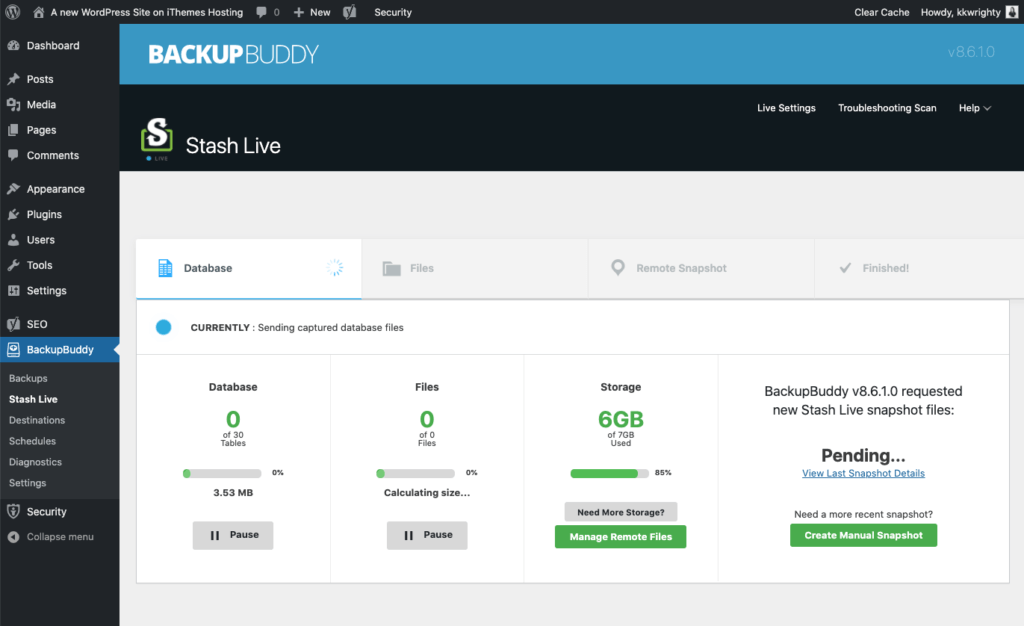
When the plugin detects a change, it immediately pushes it to a secure storage location. A WordPress backup plugin that can provide an automatic WordPress backup is the best way to go.
How to Restore WordPress from a Backup
A total website restore usually involves something that went really wrong … from a hack or security breach, a fatal error, accidentally deleted files or a server crash. Because this usually means a pretty stressful event, we want to make sure you have the instructions you need to restore your site with as little downtime as possible.
Depending on the type of restore you need to perform, there are two approaches:
- Restore Plugins, Themes and/or Individual WordPress Files – If you still have access to your WordPress admin dashboard, you can restore only the files, plugins or themes that you need to recover.
- Complete WordPress Website Restore – This approach replaces your entire WordPress installation, all files and your database with the version contained in a backup. This process is a little more intensive and requires that you have access to the files on your server plus your WordPress database.
To show how each of these approaches to a WordPress website restore works, here are instructions for restoring with the BackupBuddy plugin.
Restore Plugins, Themes and/or Individual WordPress Files
From the BackupBuddy > Backups page in your WordPress admin dashboard, navigate to the Restore tab.
Find the backup file that you will be using to restore.
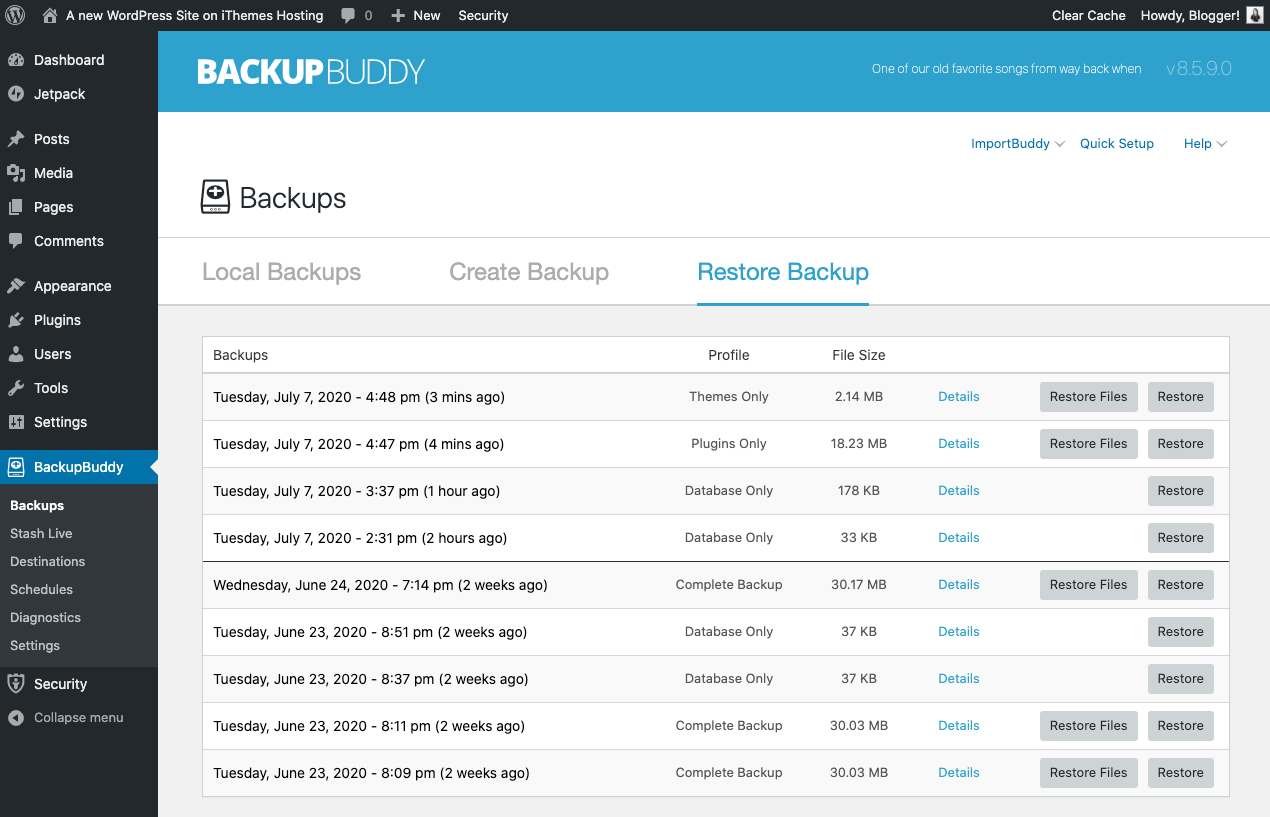
You can click the Details link to reveal more information of the backup, including the status of the backup (Good/Bad). Depending on the type of backup, you’ll also see the BackupBuddy version, WordPress version, total files, backup size and backup type of the backup.
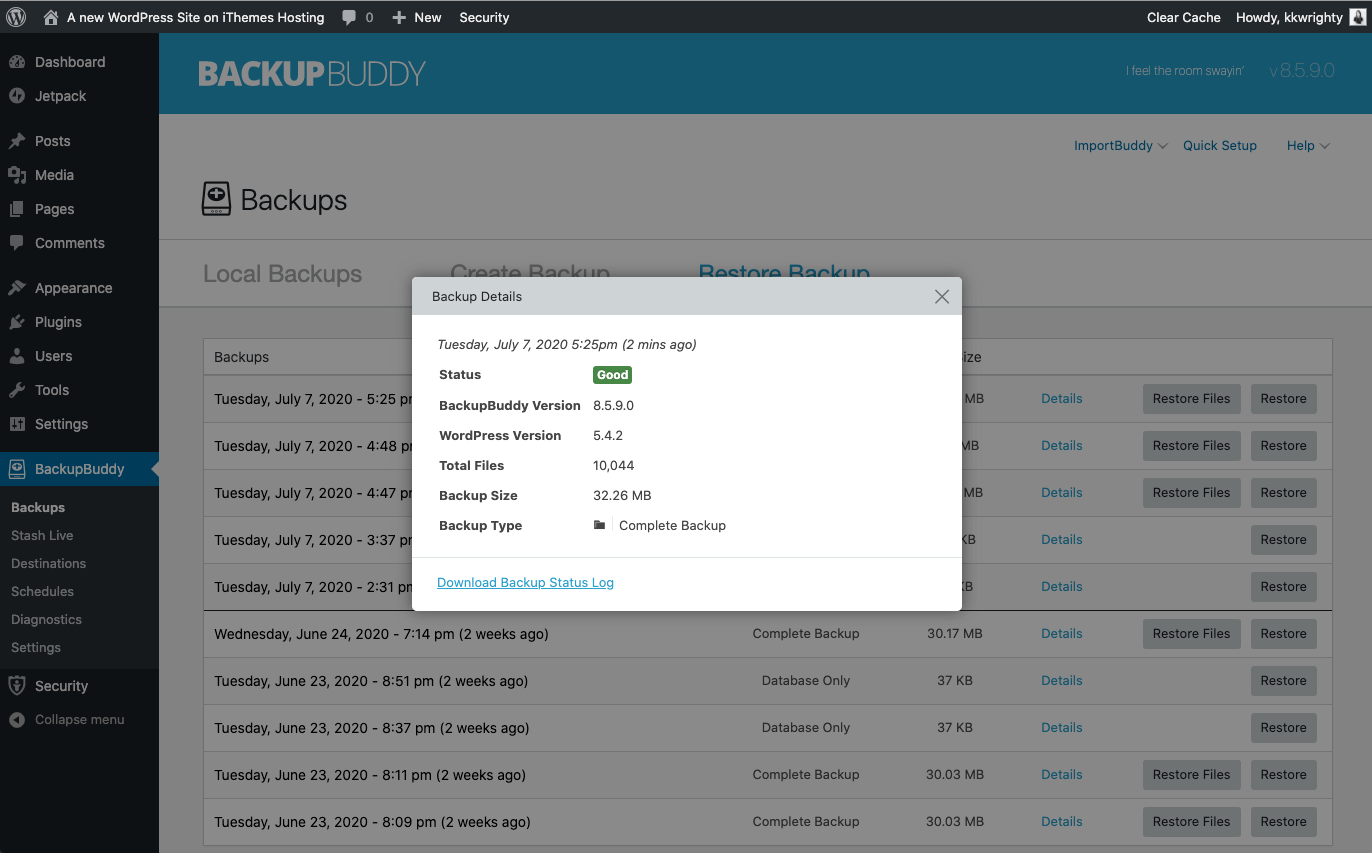
Back on the Restore tab, you can select either Restore Files or Restore depending on the type of restore you need to perform.
From the Restore tab on the BackupBuddy > Backups page, select the backup that contains the file you wish to restore. Click the Restore Files button.
In this example, we’ll restore a Media Library file, but the process is similar for any type of individual file you want to restore.
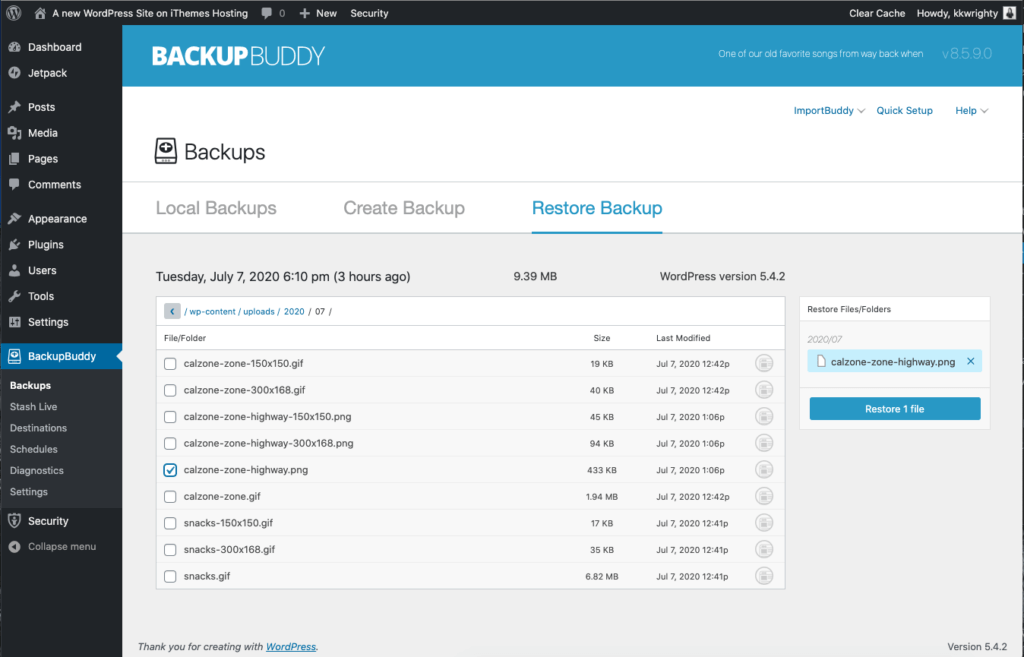
Navigate through the file picker until you find the file you wish to restore.
Note: If you’re unsure about the file you wish to restore, you can always use the file previewer to take a look at the contents of a file contained in the backup.
On the Restore Files view, click the Preview icon on the right side of the file name in the list. This is handy way to compare the contents of the file you wish to restore. While this isn’t as helpful for a media file, it’s great for reviewing the contents of code-based files.
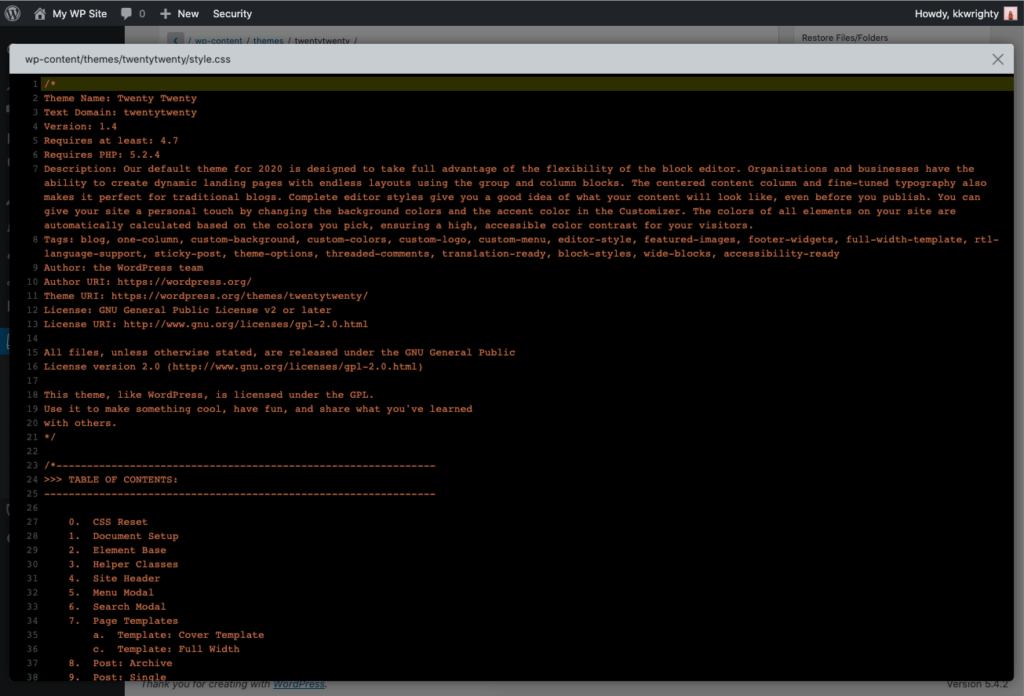
Exit out of this view, then select the file and click the blue Restore File button.
BackupBuddy will give you another notice before the file restoration begins.
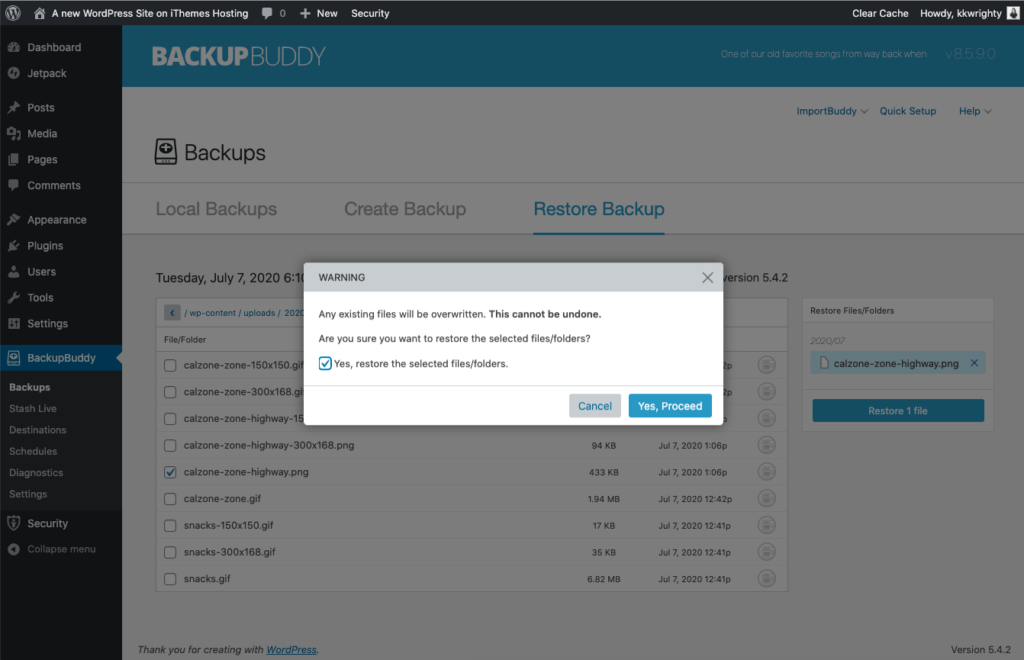
Click Yes, Proceed to begin.
BackupBuddy will then get to work restoring the file.
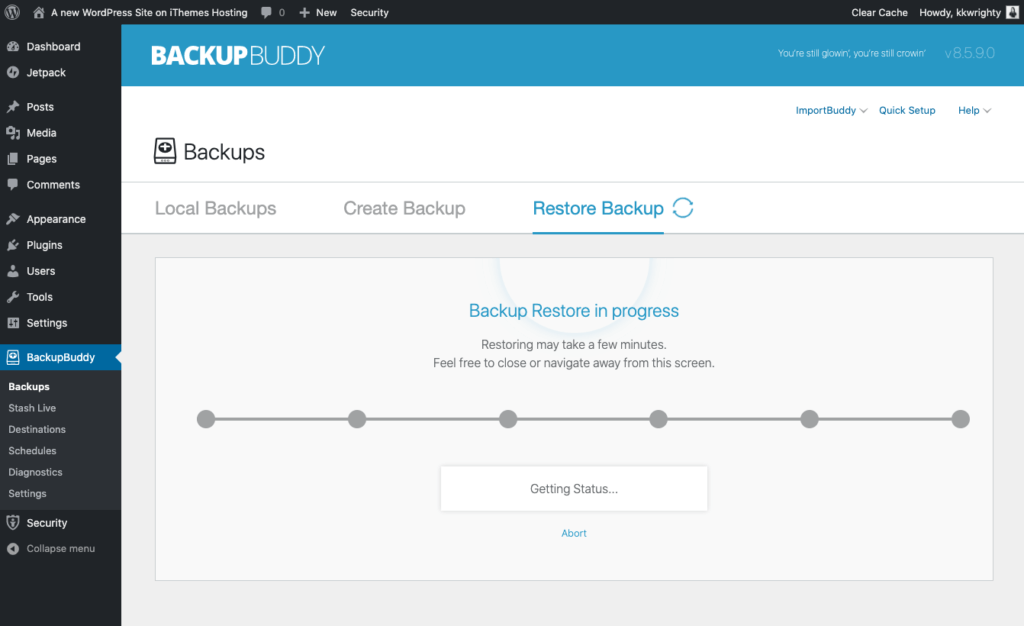
Then you’ll see a “Success” message once the file finishes restoring.
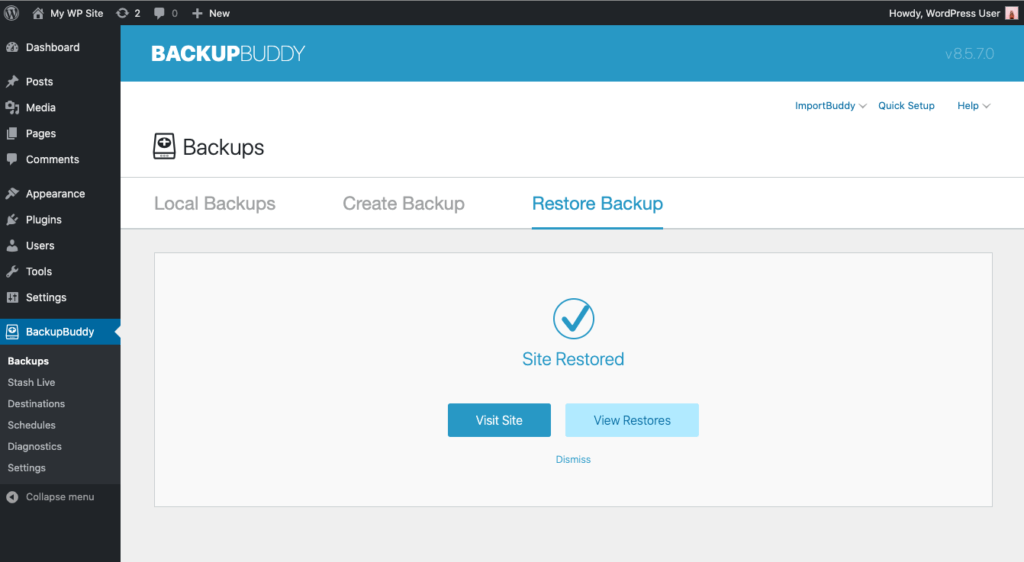
Complete WordPress Website Restore
If you need to restore your entire website and not just parts of it, this usually means you no longer have access to your WordPress admin dashboard. A Complete website restore is usually in order if your site is completely broken or unusable and the best (or only) option is to restore the entire site with a previous backup.
If a complete website restore can’t be handled inside the WordPress admin dashboard, it requires a “Manual Restoration.” We’ll need to go a few levels deeper into your website’s server, files and database to completely restore it.
Here’s a basic overview of how the BackupBuddy Complete Website Restore process works when you no longer have access to your WordPress Admin:
- You upload a file called ImportBuddy and a Complete Backup (zip) file to your website’s server.
- Through a 6-step process, ImportBuddy unpacks the Complete backup file to restore your site to the version included in the backup.
efore you begin a Complete site restore, you’ll need a few things.
- 1. A Complete backup zip file of your site made with the BackupBuddy plugin. This is a backup zip file you can download from the Remote Destination you use to store your backups such as BackupBuddy Stash. You may have also downloaded it directly to your computer.
- 2. File manager access to your website’s server (to upload files). You can usually access your website’s file through your hosting account, like cPanel’s File Manager. You can also use a text/code editor like BB Edit or Coda that allows you to connect to a server via sFTP.
- 3. Database access via PHPmyAdmin or another interface in your hosting account. You’ll need a clean/fresh database plus a database user and password with admin privileges.
- 4. The ImportBuddy file. You can download the ImportBuddy file in a couple of ways we cover in the next section. For security purposes, you’ll be asked to set a password for your ImportBuddy file in several different places throughout the BackupBuddy plugin (like during Quick Setup), depending on how you download the file.
The Best WordPress Backup Solution
BackupBuddy is the WordPress backup plugin that meets all of these requirements. Best of all, it’s contained in an easy-to-use plugin that’s perfect for novices and experts alike.
After BackupBuddy is set up, installed and running according to your specifications, don’t forget to secure your WordPress site with a WordPress security plugin like iThemes Security Pro that will keep is safe from malicious attacks of all kinds.
Your future self will thank you that you made these simple, yet highly important steps today.
10 WordPress Backup Myths
As you’ve seen in this guide, WordPress backups are serious business. But not everyone gets it. Some people have fallen for these common WordPress backup myths, allowing misinformation to endanger their website.
We’re here to dispel the WordPress backup myths. Being able to backup and restore your site is crucial. You shed a lot of sweat and tears building your site, so protect it. Let’s pour a little truth on those WordPress backup myths:
1. “WordPress Backs Up My Site Automatically”
Nope. Out of the box, WordPress has no automatic backup functionality whatsoever. It does have an export feature where you can get an XML file that contains your posts, pages, comments, custom fields, categories and tags. You have to do it yourself, it doesn’t do any kind of restore for you and it doesn’t get everything you need to fully backup and restore your site.
2. “A Database Backup is Good Enough”
Not good enough. A database backup, whether it’s the simple native WordPress export or something more complicated, only contains your site’s content. You’ve saved the words on your site, but nothing else.
Media? Nope. Design? Nope. Settings? Plugins? Themes? Customizations? Nada.
A WordPress database backup will save your content, but you’ll need a lot more to get your site back up and running. A good WordPress backup needs to include your full site.
3. “My Web Host Will Take Care Of Me”
Maybe. Many hosts offer backup. But can you afford to put your entire site in their hands alone? That might be a helpful solution in a pinch, but it’s not a backup solution you can rely on.
You have no control over how your host handles backups. Getting to the backup is dependent on them. How do you restore the backup? What if you need the backup because of a problem with your host? That problem might be impacting the backup you’re pinning all your hopes on. Or they might be too busy with their own problems to restore your site. Then what?
A host backup is a nice last resort, but it’s not the WordPress backup you should count on.
4. “I’ll Never Need a Backup”
Famous last words. That’s what people say just before tragedy strikes. You never think you’ll need a backup, until you do. And then you’re screwed.
You have to be proactive. Servers fail, updates crash, hackers get in, “someone” hits the wrong button—stuff happens. You have to be prepared.
5. “I’m Not Dumb Enough to Break My Site”
That kind of arrogance is just waiting to be proven wrong, but let’s assume you are a techie genius who isn’t going to inadvertently kill your WordPress site. Doesn’t matter. Someone else could inadvertently kill your WordPress site: an update gone bad, a half-baked plugin, a hacker. You need to protect your site from more than just your own mistakes.
6. “Hackers Don’t Care About My Site”
Oh, honey. It doesn’t matter how under-the-radar your site is. Hackers would love to get their hands on it. And they’re trying. Right now.
Don’t believe me? Install the iThemes Security plugin (it’s free), set it up and start watching the logs. Hackers are trying to log in using stolen or cracked passwords. Robots are hunting for malicious code and wracking up the 404 errors.
It’s a sobering reality.
7. “Well I Backed Up Once, So I’m OK”
Nice try. How ancient is that backup? How much has changed since then? You should be updating your site and that means creating new backups on a regular basis.
Your backup needs to be consistently scheduled and automatic. It’s too easy for last month’s backup to become last year’s backup, and that’s not good enough.
8. “A Backup Is Too Much Work”
Really? Clearly you haven’t tried BackupBuddy. You can get backups going in minutes. You can schedule them. They’re automatic.
It’s easy. Yes, you need to set it up. Yes, you should check in periodically to make sure everything is working. But WordPress backup is not hard.
9. “A Single, Local Backup is Plenty”
Not quite. Backing up to a single location is never a good idea. You’re putting all your eggs in one basket, and that’s asking for trouble.
If that single backup site is your computer, it could crash, get stolen, or be susceptible to natural disasters.
The same is true of a single off-site location.
Your best bet is to have multiple local and off-site backup locations. BackupBuddy even includes free offsite storage with Stash.
10. “A Backup Is Just for Catastrophic Failures”
Maybe you’re crazy enough to role the dice and hope you’re not one of those catastrophic failures. But even if you are crazy and lucky, a WordPress backup is still tremendously helpful for everyday uses:
- Accidentally delete an image? You can restore single files.
- BackupBuddy’s restore feature makes it easy to transfer entire sites. Developers use this all the time to build sites locally and then transfer them to the web.
- BackupBuddy can scan for malware, repair your database and more. It’s more than just backup.
And because 10 WordPress backup myths isn’t enough, here’s a bonus myth:
11. “A Backup Is Too Expensive”
Not at all. You can get BackupBuddy for two sites for $80 per year. That’s a small price to pay for peace of mind.
7 WordPress Backup Lessons
To wrap up this guide, here are a few lessons we’ve learned when it comes to WordPress backups in our 10 years of backing up millions of WordPress sites.
We actually built the BackupBuddy plugin back in 2010 because we lost our own website and had to completely rebuild it … twice. You can read the whole origin story of BackupBuddy now that we can finally talk about it without crying: From Server Crashes, Tacos, and Coffee: The Birth of BackupBuddy.
Back then, WordPress didn’t have any backup solutions, so we built BackupBuddy so that no one would ever have to go through what we did: 120 hours—3 entire work weeks—lost on site failures.
1. Backups allow a good night’s sleep.
A backup allows you to rest at night knowing that if anything does happen to your site, you have an easy restoration process. Here’s a story that illustrates the point, told to us by a customer:
“I remember one client who had a WordPress site that generated new content multiple times a day. They called me one Thursday to let me know the site had “problems.” Sure enough, the server’s hard drive had failed and, at the time, I had been relying on the hosting company’s backup capability. This proved to be a poor choice because the backups the hosting company created were only on a weekly basis and took place on Sunday. So not only did I have to struggle getting the backup from the hosting company restored, (at one point there were three copies of the same site on the server), but I had to chase down all the content that had been written on the site that week.
Enter BackupBuddy. BackupBuddy provided the ability to schedule both full site backups as well as a basic database backup whenever I want so that I can almost guarantee I’ll never have to scramble to find content or wrestle with site reconstruction projects when something goes wrong with my WordPress sites.”
2. Simply having a WordPress backup isn’t enough. You need to be able to use the backup for whatever situation presents itself.
Simply having a backup is not the important part of the equation. If you can’t schedule and make backups 24 hours a day, but if there’s no easy way to get the data out of the backup or to restore the site quickly, the security a WordPress backup provides is wasted.
When deciding on your backup solutions for your WordPress site, you need to take three factors into consideration:
- Can I quickly restore my complete site in just a few seconds?
- Can I recover an individual file from the backup in just a few moments?
- Can I transfer my site to a new server, domain and/or location at the drop of a hat?
If you can answer yes to all three of these questions, then you have a quality backup solution. For WordPress sites, you will be hard pressed to find anything coming close to the power of BackupBuddy. In addition to answering yes to those three questions, BackupBuddy can do so much more.
3. The process of making a backup doesn’t have to slow down your server or take up your valuable time.
It is surprising how many people we’ve talked to over the years who say they do not have the time to do backups on their site. They claim they are too busy and backups take too much time. We have even heard people tell me that they don’t do backups because when they start a server backup during working hours they slow everything down in the office and co-workers get mad at them.
Over the years we have learned that we need to make our WordPress backup solutions work FOR us and avoid putting ourselves in situations where the WordPress backup solution makes US do the work.
Two rules of WordPress backups are:
- Always schedule backups to occur automatically so forgetting isn’t an option.
- Take advantage of “slow” times on your site to make your backups. (Even if that means 3am on a Sunday morning.)
4. Knowing when you need a backup is not a difficult decision if you follow these simple rules.
- Rule #1 – All content (posts, pages, and “things you write in the WordPress admin area”) are stored in your WordPress database. If you write a post, you need a database backup. If someone makes a comment or makes a purchase, you need a database backup to capture that change.
- Rule #2 – A full (complete) WordPress site backup must include plugins, themes, files on the server, or additional folders that may or may not be part of WordPress. Any time you upload a new theme, add/update a plugin, modify the functions.php file of the theme … you need a full site backup.
If you follow these two rules you will NEVER be left with lost content when something goes wrong with your WordPress site.
5. Choosing a storage location to use for WordPress backup files is not as important as choosing how many locations to use for your backups.
One of the worst things we can hear about WordPress backups is that they are stored on the same server as the website. The usefulness of a backup goes to almost zero if it is stored in the same location as the site it is backing up. In fact, simply sending that backup to one other location may not be the best solution either.
Here’s a scenario that may be all too familiar:
You have an important client that is about ready to launch their brand new website you built for them. The morning of the launch, their hosting company is having trouble. So you quickly go to grab the backup files so you can transfer the site to a new server, but Amazon S3 is down for maintenance because Netflix got hacked. Now there is no way to get a copy of the backup files and you are at the mercy of other companies.
Having WordPress backups stored in multiple locations, even physical copies of the backups on hard drives, can make the difference between successfully navigating the storms of a broken site and sitting around waiting for hosting company’s support tickets to be answered.
6. WordPress backups can help you make steady, recurring revenue if you build websites for clients.
If you build websites for clients, WordPress backups can become a part of a WordPress maintenance plan for recurring revenue. WordPress maintenance services include things like backups, updates, security and much more.
A tool like iThemes Sync Pro can help you generate and send WordPress maintenance reports to clients to show clients the value of what you do.
In addition, a WordPress backup does not have to be a virtual storage of bits and bytes on some cloud storage device. It can be a physical deliverable in an ongoing contract with a client. For many freelance web developers, the idea of a physical deliverable as part of a milestone-based contract can be very foreign.
A physical copy of a backup can also serve as an easy method of keeping the communication channel open between the client and the developer. Many freelancers have stated that they find it difficult to stay in touch with clients after the initial development/design finishes.
Having the ability to physically mail a client a “monthly” backup to the client along with a short letter about the status of the site (data points, basic analytical stats, etc.) can keep that communication line open. We heard about one client who had no clue what to do with the backups but he kept them all in order on a shelf in the office and he admitted that it made him feel safe that at any time he could grab the latest copy of the site and take it with him.
7. Most people don’t realize they need a WordPress backup until they need a backup.
What is one of the primary purposes of having insurance? Car insurance exists to financially protect in case of an accident. Life insurance exists to provide for those that remain in case of something happening to the insured. Business insurance policies exist to protect the continuance of a business in case something outside of normal operations occurs. In all these cases the key term is “in case” something happens. Therefore, would it not make sense that a website carries some sort of “insurance policy”?
Don’t be someone who finds out they need a WordPress backup when it’s too late!
Wrapping Up: A Plan for WordPress Backups
After reading this guide, we hope you have a solid understanding of the importance of WordPress backups, how to implement your own WordPress backup strategy and more. We hope we answered all your questions about backing up your WordPress site.
With just a little effort, you can make sure your WordPress website is safe and protected with backups that run like magic.
Get BackupBuddy now
Sign up now — Get SolidWP updates and valuable content straight to your inbox
Sign up
Get started with confidence — risk free, guaranteed